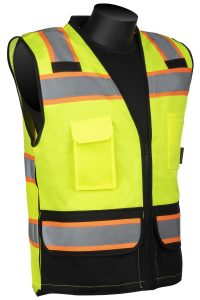Construction Safety Week, May 2- 6
A safe and healthy worksite promotes workers’ mental well-being. This year’s Construction Safety Week takes a closer look at the connection. We’ll expand that focus by exploring some of the more obvious and often overlooked worksite hazards that can undermine a worker’s state of mind and their confidence to do the job.
According to the Construction Safety Week website, it’s essential to see the signs of struggle that impact safety and productivity. It also means ensuring our workers are equipped with the resources and support to work safely every day.
This post will review this year’s theme for the week and what it means for building a safe worksite. We’ll then zero in on two common worksite risks that may unknowingly create an undercurrent of stress for your workers.
Working with Confidence
The theme of Construction Safety Week is “Connected – Supported – Safe.” It centers around the idea that straightforward access to honest communication and connection supports a worker’s mental health.
“Construction Safety Week provides the opportunity, encouragement, and resources to build awareness around topics that aren’t always openly discussed, including this year’s topic of mental health,” said Marc Malezija from the OES Group, a company that has represented manufacturers of occupational, environmental, and safety products for over 27 years.
“Safety for construction companies has to be built into their daily culture, but what Construction Safety Week does is enable employers to step back and focus on an area that is of particular concern right now,” said Marc.
He added that listening to and addressing a worker’s concerns about the daily hazards they face can help alleviate some of the stress that affects a worker’s mental health.
Struggling with Worksite Stress
The Construction Safety Week website cites industry research that shows 1 in 5 construction workers struggle with depression and other mental health issues.

According to the Construction Industry Rehabilitation Plan (CIRP), a non-profit addiction treatment program founded solely for the construction industry, 83% of construction workers have experienced a mental health issue.
High levels of stress, anxiety, and depression are prevalent in those people in the industry because they confront a unique combination of factors, including often working with an injury.
Moreover, a study published by the Journal of Occupational and Environmental Medicine found that stress in construction is often associated with pain from injuries.
In an article for BC Building Trades, Vicky Waldron, Executive Director of CIRP, commented that the workplace significantly impacts mental health. “Creating a psychologically safe work environment can help improve high-stress levels in workers.”
Two obvious hazards stand out for a construction worksite – fast-moving vehicles and dangerously sharp tools and materials.
Moving Vehicles: Addressing Work Zone Safety
Construction workers around busy traffic areas or even large moving machinery are at a very high risk of accidents involving those vehicles.
OSHA stresses the importance of properly setting up work zones at construction sites. They recommend work zones are set up with barriers, flagging, and lighting to keep workers safe.
In addition, OSHA requires workers to wear high visibility vests. It’s essential personal protective equipment (PPE) for a safe worksite, compliance, and a worker’s peace of mind.
| HiVizGard™ Surveyor’s Vest with Black Bottom | HiVizGard™ Engineer Surveyor’s Vest |
 |
 |
Compliant with ANSI/ISEA 107-2020 standards, the HiVizGard™ Engineering Surveyors Vests are work gear that ensures construction workers are seen on the worksite.
Sharp Building Materials: Protecting a Worker’s Hands
EHS Today reports hand injuries stemming from the sharp edges of building materials as a common accident on construction sites. It’s why another critical piece of PPE keeping workers safe includes work gloves with the appropriate level of cut protection.
“With work glove cut ratings, there’s a lot of confusion around what level of protection to use for particular projects or applications,” Marc said. “It can add a lot of anxiety around choosing a glove.”
Marc said most of their construction worker customers choose a multi-purpose foam-coated glove with an A4 cut rating. It’s a glove that offers just the right level of protection and can still be comfortable to wear for a wide variety of jobs.
Along with cut protection, work gloves built for jobs specific to settings like construction sites should:
- Embrace each finger without gaps
- Have a snug fit around the wrists
- Allow free movement
For more information on choosing the best cut resistant gloves for your crew download our free guide.
| Ultra-Z™ A4 Cut Resistant | Z-Grip™ A4 Cut Resistant |
 |
 |
Both gloves offer A4 cut protection, but the Z-Grip™ is a 13 gauge glove while the Ultra-Z™ is 18 gauge with touch screen compatibility.
Building a Safe Environment
A safe and healthy workplace protects workers from injury and illness. It can also lower overall stress levels among the crew while raising morale. In other words, safety is good for a worker’s mental health.
Projects and people thrive in a safer, caring environment that includes mental health as part of its safety plan. When a company prioritizes safety, it attracts and keeps better employees, runs more efficiently, and ultimately produces more satisfied workers.
For more information and access to various helpful resources on mental health concerns in the construction industry, see the Construction Safety Week resources page.
When it comes time to find the best selection of PPE to keep your worksite safer, Liberty Glove and Safety can help. Contact us to learn more about our personal protective equipment line, and don’t forget to ask about our sample program.


